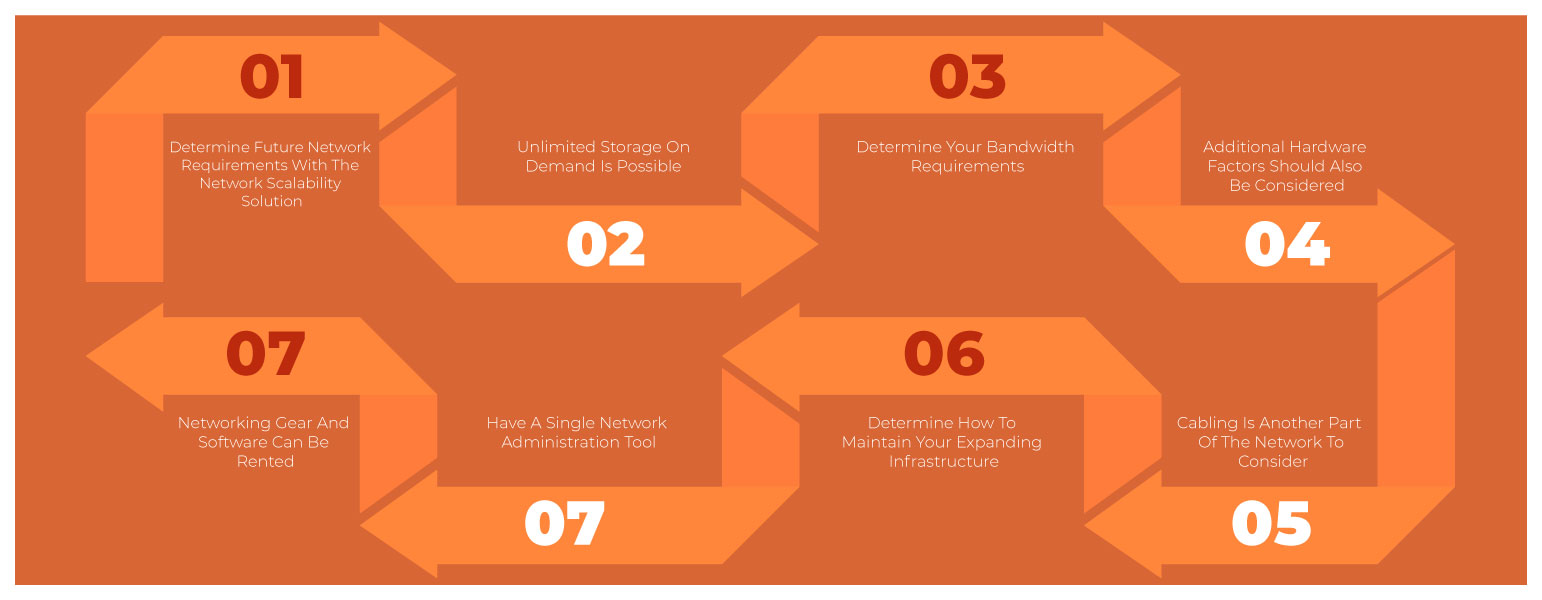

The capacity of a network to manage rapid variations in workload caused by sudden spikes or reductions in the volume of data it processes is referred to as network scalability. If, for example, you went on a recruiting binge and increased your staff count from 100 to 300 employees in one day, your network would be considered extremely scalable if its performance could be quadrupled while just doubling your network expenditure.
To get the Network Scalability solution let’s look at some tools and ideas,
Determine Future Network Requirements With The Network Scalability Solution
The network scalability solution assisted in driving data via decision-making to save money and improve network performance. Determine the number of devices that will require an internet connection.
By adding resources to a physical system, such as increased processing power to a server to make it quicker, a network scalability solution boosts the capacity of hardware or software. When extra capacity is needed, scale-up storage entails adding new devices, such as disc drives, to an existing system.
To function as a single logical entity, a network scalability solution consists of several components. This entails adding devices to linked arrays or clusters for scale-out storage.
Unlimited Storage On Demand Is Possible
Consider how the number of internet-connected equipment has increased over time, and then estimate how many internet-connected devices you’ll require in a year. Remember to include Internet of Things (IoT) devices like security cameras and factory sensors in your calculations. The type and number of routers you require in the office will be determined by this. Business-grade wireless routers can connect up to 250 devices to the internet as of this writing; however, wired/ethernet connections can only allow one to four devices per router.
Determine Your Bandwidth Requirements
With bandwidth monitoring tools, examine how your network resources are being utilized, then use your expected device count to estimate how much bandwidth your team will need in the future. If you often utilize VoIP and video streaming, for example, you may want significantly more bandwidth to develop and future-proof your company.
Additional Hardware Factors Should Also Be Considered
Networking equipment consumes both physical space and power. If your current site doesn’t have enough room for all of the new devices coming in or doesn’t have backup power in case of outages, you’ll need to relocate.
Cabling Is Another Part Of The Network To Consider
Hire a managed IT services provider (MSP) with expertise in installing network cabling; they’ll know which cables are best for your future demands and how to build installations that are free of physical dangers and other problems.
Determine How To Maintain Your Expanding Infrastructure
Focusing on providing your value offer is essential for business growth. If you manage your network through the Network Scalability solution alone, you’ll likely only be able to respond to IT issues as they arise, falling behind as your network expands and your problems multiply. Allow an MSP to proactively monitor and resolve security and network issues to save you time and money
Have A Single Network Administration Tool
Network Scalability solution are often patchworks of separate products with varying or contradictory needs and dependencies. These factors make the solutions costly to maintain and prone to failure, especially when it comes time to extend the network. Consult an MSP about deploying an all-in-one network scalability solution to build up a scalable network.
Networking Gear And Software Can Be Rented
Technology is becoming outdated at an increasing rate. This makes acquiring your gear and software more difficult to justify with each passing quarter, yet you must employ the finest tools available to stay competitive. Instead of leasing networking devices (also known as Infrastructure-as-a-Service or IaaS), you should subscribe to Software-as-a-Service (SaaS).
You may stretch the cost of utilizing computers over time using IaaS, paying less than the entire cost of that equipment over the leasing period, and even trading up when new technology is introduced. SaaS also allows you to stretch the cost of utilizing software (rather than paying for a costly lifetime license all at once), as well as receive continual updates, improvements, and tech assistance from the developer.
Instead Of Scaling Up, Scale-Out
If your networking provider only allows you to migrate from one service module (referred to as a “switch”) to another that meets your capacity requirements, switch to one that allows you to utilize several switches. A switch is similar to a faucet: a large faucet allows more water to flow than a tiny faucet, and an elevated switch can handle more network traffic than small switches.
The issue with a provider who limits you to one switch is that you can’t go above and beyond that vendor’s highest-capacity switch. When your lone switch breaks, your entire network goes down, this is costly.
The vendor who allows you to utilize multiple tiny switches, on the other hand, can allow you to raise or reduce the number of switches as your bandwidth requirements vary. In addition, if one little swap fails, it will be simply one among several. The network performance loss will be minor and very brief.
Your expanding organization needs a network scalability solution that can keep up, as well as an IT partner to help you create and maintain that network. Allow XBASE Technologies Corporation to serve as your IT partner. Our Exponentially BetterTM IT services have helped numerous organizations achieve new heights; contact us to see how we may help you do the same.
5 Tips For Network Success
In 2020 and beyond, here are five suggestions for scaling your network rather than your complexity.
For years, expanding your capacity to meet rising demands required adding more and larger hardware-based platforms to your infrastructure as needed. This eventually leads to a level of complexity that is no longer profitable.
The year 2020 will usher in a new era of high-bandwidth, low-latency, and Network Scalability solutions which will put even the most advanced, scalable, and intelligent networks to the test. How can you stay up with traffic needs, innovate, and grow your network to capitalize on commercial prospects like 5G, IoT, and Multi-access Edge Computing (MEC)?
Our five recommendations for network success in 2020 and beyond are as follows:
- Move away from “increasing network capacity” and toward “scaling the network on demand.” The only way to keep up with traffic growth in the 5G and IoT era will be to transition from slowly increasing network capacity to constructing a more flexible and programmable system. Modern, programmable infrastructure will be required in the future decade, together with sophisticated edge network orchestration powered by confined automation.
- Use a programmable platform to get new services to market faster. Turning up a new service in a dynamic multi-vendor environment might take several weeks or more with manual deployment, setup, and provisioning. For most clients, this is way too lengthy. On the other hand, advanced programmable or network Scalability Solution and network automation tools minimize time-consuming, error-prone manual procedures, allowing you to launch new services in minutes rather than weeks or months.
- Cut infrastructure expenses by implementing efficient, convergent transportation systems. Network Scalability solution sprawl and costly real estate, electricity, and continuing operational expenses result from operating separate optical and packet networks. By concentrating on Multi-Layer Optimization (MLO) concepts and using convergent packet-optical architecture, you may reduce the number of devices in your network by up to 50%. You’ll be able to handle a variety of service types, including residential broadband, private line, and enterprise business services, as well as 4G/5G mobile services, all while saving money for your company.
- Simplify the network to save administration expenses and needs. The requirement for specialized skills and protocol expertise to administer, maintain, and debug a network grows when it has outdated or unsupported infrastructure. Replace full-featured IP/SR routers and other outdated equipment with lightweight, purpose-built infrastructure that can be managed centrally using a network-hosted control plane. You’ll lessen your dependency on expert skills, cut expenses, boost service velocity, and keep your customers happy with the Network Scalability solution.
- Migrate important old services to a contemporary packet-based network. Legacy services’ dependability, quality, and cost-efficiency diminish when infrastructure becomes older and more difficult to sustain. Consider progressively transitioning your outdated services to a contemporary, scalable, and high-performance network Scalability Solution. The correct infrastructure will mimic your legacy services, letting them run smoothly in your new environment while being managed and supported using widely accessible packet networking and IT expertise. You can assure uninterrupted services and SLA compliance while lowering OPEX with this technique.
In The Bottom Line
If you follow these five guidelines, your network will be prepared to confront an ever-changing future, ready to adapt, scale, and respond to any opportunity. ITSol24x7 is assisting operators all around the world with highly efficient, Adaptive IPTM-based networks to future-proof their offerings. As a consequence, on-demand programmable scalability, real-time analytics for intelligent network Scalability Solution, and lean IP features offer a broad variety of corporate and residential services on common and simple network architecture.
Read related: SDLC Design Phase Is More Important Than You Think

 +1 647 936 6616
+1 647 936 6616

